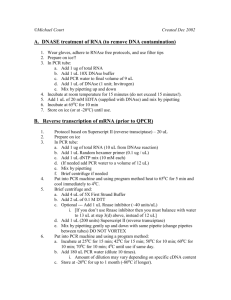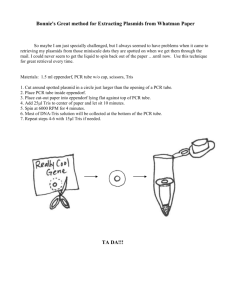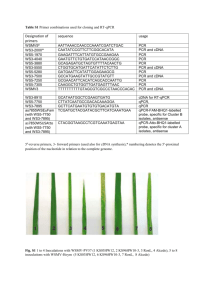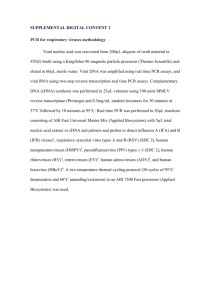Q-RT-PCR
advertisement
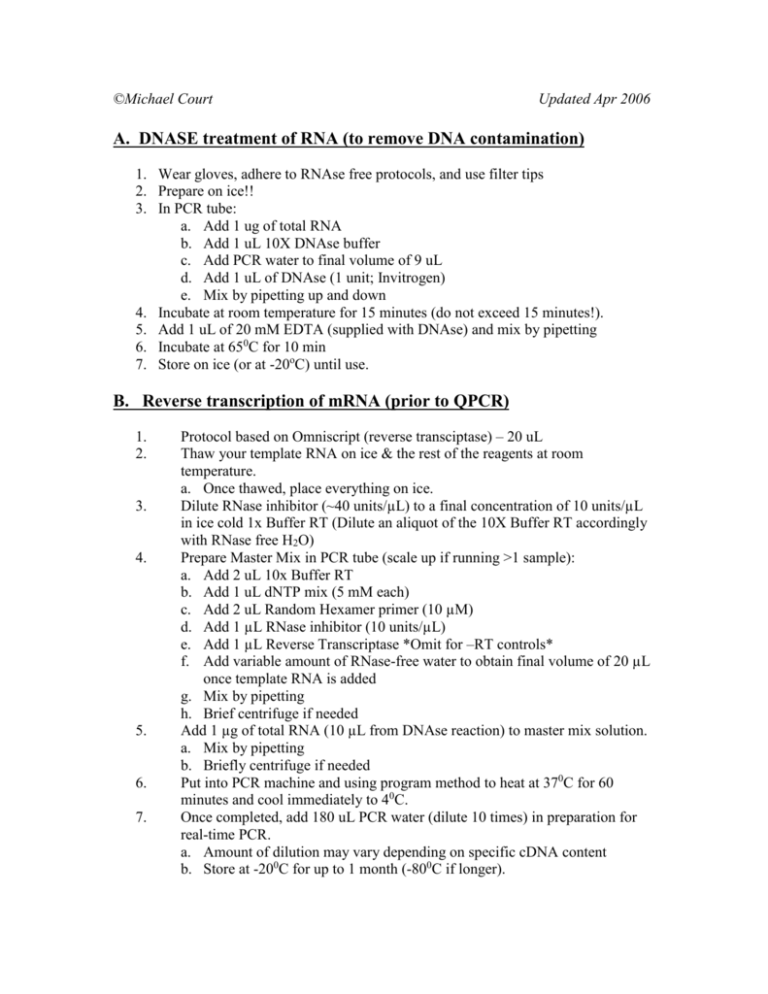
©Michael Court Updated Apr 2006 A. DNASE treatment of RNA (to remove DNA contamination) 1. Wear gloves, adhere to RNAse free protocols, and use filter tips 2. Prepare on ice!! 3. In PCR tube: a. Add 1 ug of total RNA b. Add 1 uL 10X DNAse buffer c. Add PCR water to final volume of 9 uL d. Add 1 uL of DNAse (1 unit; Invitrogen) e. Mix by pipetting up and down 4. Incubate at room temperature for 15 minutes (do not exceed 15 minutes!). 5. Add 1 uL of 20 mM EDTA (supplied with DNAse) and mix by pipetting 6. Incubate at 650C for 10 min 7. Store on ice (or at -20oC) until use. B. Reverse transcription of mRNA (prior to QPCR) 1. 2. 3. 4. 5. 6. 7. Protocol based on Omniscript (reverse transciptase) – 20 uL Thaw your template RNA on ice & the rest of the reagents at room temperature. a. Once thawed, place everything on ice. Dilute RNase inhibitor (~40 units/µL) to a final concentration of 10 units/µL in ice cold 1x Buffer RT (Dilute an aliquot of the 10X Buffer RT accordingly with RNase free H2O) Prepare Master Mix in PCR tube (scale up if running >1 sample): a. Add 2 uL 10x Buffer RT b. Add 1 uL dNTP mix (5 mM each) c. Add 2 uL Random Hexamer primer (10 µM) d. Add 1 µL RNase inhibitor (10 units/µL) e. Add 1 µL Reverse Transcriptase *Omit for –RT controls* f. Add variable amount of RNase-free water to obtain final volume of 20 µL once template RNA is added g. Mix by pipetting h. Brief centrifuge if needed Add 1 µg of total RNA (10 µL from DNAse reaction) to master mix solution. a. Mix by pipetting b. Briefly centrifuge if needed Put into PCR machine and using program method to heat at 370C for 60 minutes and cool immediately to 40C. Once completed, add 180 uL PCR water (dilute 10 times) in preparation for real-time PCR. a. Amount of dilution may vary depending on specific cDNA content b. Store at -200C for up to 1 month (-800C if longer). C. Quantitative real-time PCR (SYBR green method) 1. Based on ABI Sybr Green 2X master mix kit and PE 5700 QPCR thermal cycler 2. Thaw cDNA on ice a. [Return remaining cDNA immediately to freezer once used!] 3. PCR setup can be done at room temperature and stored overnight at 40C a. DO NOT FREEZE enzyme mix 4. Data should be normalized to a house-keeping gene; currently 18-S-RNA appears to be the least variable of all genes a. Need DNAse treatment since no introns in 18SRNA. 5. For each PCR tube prepare the following in a 1.5 mL microcentrifuge tube (Solution A): a. 1 uL Forward primer (5 uM; 5 pmole/uL) b. 1 uL Reverse primer (5 uM; 5 pmole/uL) c. 0.5 uL PCR water d. 12.5 uL 2X Sybr green master mix e. Prepare enough for each tube plus 10 - 20 % more to account for pipetting waste f. Mix by pipetting 6. Add 15 uL of Solution A to each PCR tube a. Use special ABI “Optical” PCR strip tubes and caps 7. To each PCR tube add 10 uL diluted cDNA and mix by pipetting a. Generally cDNA from RT reaction can be diluted 1/5 to 1/20 b. Dilute enough such that Ct values are >15 but <30 cycles c. Should include NTC – no template control (10 uL PCR water) d. Initial evaluation should also include NRTC (no reverse transcriptase control) e. Standard curves can be generated using serial dilutions of cDNA with highest content of mRNA of interest 8. Cap tubes and place in PE 5700 QPCR machine 9. Run at 950C for 10 minutes and then 40 cycles of 950C for 15 sec and 600C for 1 min. 10. Specificity should be checked by: a. Running a melting curve analysis at end of PCR – should only see a single sharp peak b. Running PCR products on a 2% agarose gel – should only see one band i. BUT Sybr green can cause anomalous motility – so may need to run separate reaction without Sybr green c. Purifying and sequencing product
